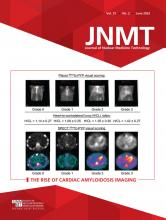Abstract
Cardiac amyloidosis (CA) is an infiltrative cardiomyopathy resulting from deposition of insoluble amyloid protein in the myocardial interstitium. The accumulation of amyloid protein causes the myocardium to thicken and stiffen, leading to diastolic dysfunction and, eventually, heart failure. Two primary types of amyloidosis—transthyretin and immunoglobulin light chain—account for nearly 95% of all CA diagnoses. Three case studies are presented. The first demonstrates a patient positive for transthyretin amyloidosis, the second demonstrates a patient positive for light-chain CA, and the third demonstrates a patient showing blood-pool uptake on the [99mTc]Tc-pyrophosphate scan but negative for CA.
- light-chain cardiac amyloidosis
- transthyretin cardiac amyloidosis
- 99mTc-pyrophosphate imaging
- echocardiography
- MRI
Cardiac amyloidosis (CA) is an infiltrative cardiomyopathy resulting from deposition of insoluble amyloid protein in the myocardial interstitium. Recognition of myocardial scintigraphy, with bone-avid tracers providing a confirmatory diagnosis of transthyretin CA with high diagnostic accuracy, has resulted in a rapid increase in the use of these scans. The resultant improved diagnosis of transthyretin CA has allowed for the timely implementation of novel targeted therapies to reduce morbidity and mortality from this otherwise fatal disease. Thus, an accurate diagnosis of transthyretin CA must be established by limiting false-positive results on cardiac scintigraphy and distinguishing transthyretin CA from the other commonly encountered form of CA, light-chain CA.
CASE REPORT
Case 1
An 82-y-old African American man presented with symptoms of heart failure, consisting of new shortness of breath on exertion and lower-extremity swelling. He was admitted to the hospital for management of heart failure and diagnostic workup. His heart rate and blood pressure on admission were 103 bpm and 141/65 mm Hg, respectively. His electrocardiogram showed atrial fibrillation with inferior myocardial infarction and a low-voltage QRS complex (Fig. 1A). Cardiac troponin I levels were borderline-high, at 0.028 ng/mL (reference level, 0.000–0.039), and the brain natriuretic peptide level was 235 pg/mL (reference level, <100 pg/mL). A transthoracic echocardiogram showed severe left ventricular hypertrophy with an end-diastolic interventricular septal thickness of 2.0 cm (reference thickness, 0.6–1.1 cm), along with an apical-sparing pattern (cherry-on-top pattern) on speckle-tracking strain echocardiography (Figs. 1B and 1C).
(A) Electrocardiogram showing atrial fibrillation, inferior myocardial infarction pattern, and low QRS voltage. (B) Transthoracic echocardiogram showing severe left ventricular hypertrophy in parasternal long-axis view. (C) Speckle-tracking strain echocardiogram showing apical-sparing pattern. (D) Contrast-enhanced cardiac MRI showing diffuse gadolinium enhancement in left ventricle. (E) Parametric mapping depicting elevated native myocardial T1 at 1,260 ms and abnormal extracellular volume, at 60%. (F and G) [99mTc]Tc-pyrophosphate scintigraphy, with anterior planar view depicting grade 3 tracer uptake (F), confirmed on cardiofocal SPECT reconstruction (G). Cardiac boundaries are well depicted in short-axis, horizontal long-axis, and vertical long-axis orientations. H/CL = heart–to–contralateral-lung ratio.
The patient was referred for cardiac MRI to determine the cause of his cardiomyopathy. Although confirming severe left ventricular hypertrophy, cardiac MRI also demonstrated an inability to suppress the myocardial signal 8–10 min after gadolinium administration, along with diffuse myocardial late gadolinium enhancement (Figs. 1D and 1E). Additionally, myocardial native T1 and extracellular volume were abnormally elevated, at 1,260 ms (reference value, <1,050 ms) and 60% (reference value, <30%), respectively. On the basis of these findings, suspicion of CA was raised, and the patient was referred for [99mTc]Tc-pyrophosphate scintigraphy. Planar imaging and SPECT were performed 1 h after injection of 577.2 MBq (15.6 mCi) of [99mTc]Tc-pyrophosphate (1). Scintigraphy revealed marked myocardial uptake on planar images, with a visual score of 3 (a grade of >2 being positive for CA) and a heart–to–contralateral-lung ratio of 2.1 (>1.5 at 1 h being abnormal), confirmed on tomographic imaging (Figs. 1F and 1G). Light-chain assays were within reference limits, and this finding, along with a markedly positive [99mTc]Tc-pyrophosphate scan, confirmed the diagnosis of transthyretin CA. The patient was referred for genetic testing, which did not reveal the presence of any pathognomic mutation, and treatment was begun with tafamidis for wild-type transthyretin CA (2).
Case 2
An 80-y-old Hispanic man with a past medical history of carpal tunnel syndrome was admitted to the hospital for workup of new shortness of breath on exertion, orthopnea, and reduced exercise tolerance. He did not report a family history of cardiovascular disease. His heart rate and blood pressure at the time of admission to the hospital were 88 bpm and 132/72 mm Hg, respectively. His initial electrocardiogram was consistent with normal sinus rhythm, first-degree atrioventricular block, inferior myocardial infarction, and low QRS voltage in the limb leads (Fig. 2A). Serum troponin I levels and brain natriuretic peptide were 0.178 ng/mL (reference level, 0.000–0.039 ng/mL) and 768 pg/mL (reference level, <100 pg/mL), respectively. A transthoracic echocardiogram showed severe left ventricular hypertrophy with an interventricular septal thickness of 1.8 cm and an apical-sparing pattern, raising suspicion of CA (Figs. 2B and 2C). Further testing by cardiac MRI confirmed mild concentric left ventricular hypertrophy. It also showed an inability to suppress the myocardial signal 8–10 min after gadolinium administration, along with diffuse late gadolinium enhancement of the myocardium and an elevated native myocardial T1 of 1,194 ms. The extracellular volume was elevated, at 54% (Figs. 2D and 2E).
(A) Electrocardiogram showing sinus rhythm with first-degree atrioventricular block and low QRS voltage in limb leads. (B) Transthoracic echocardiogram showing severe left ventricular hypertrophy in parasternal long-axis view. (C) Speckle-tracking strain echocardiogram showing apical-sparing pattern. (D) Contrast-enhanced cardiac MRI showing diffuse gadolinium enhancement in left ventricle. (E) Parametric mapping depicting elevated native myocardial T1 at 1,194 ms and elevated extracellular volume, at 54%. (F) [99mTc]Tc-pyrophosphate scintigraphy, with anterior planar view depicting grade 1 tracer uptake. (G) Cardiofocal SPECT reconstruction confirming lack of myocardial tracer uptake. H/CL = heart–to–contralateral-lung ratio.
Because there were several CA red flags, the patient was referred for [99mTc]Tc-pyrophosphate scintigraphy. Planar imaging and SPECT were performed 1 h after administration of 699.3 MBq (18.9 mCi) of [99mTc]Tc-pyrophosphate (Figs. 2F and 2G). Simultaneous assessment of serum monoclonal proteins was also performed. [99mTc]Tc-pyrophosphate scintigraphy revealed no significant myocardial tracer uptake, suggesting the absence of transthyretin CA. However, serum light-chain assessment was abnormal, with a κ/λ ratio of 0.05 mg/L (reference level, 0.26–165 mg/L). The serum immunofixation electrophoresis revealed an elevated level of free λ light chain, at 580.6 mg/L (reference level, 5.7–26.3 mg/L), and an elevated level of free κ light chain, at 27.3 mg/L (reference level, 3.3–19.4 mg/L). On the basis of these findings, the patient was emergently referred to hematology, and a diagnosis of multiple myeloma and light-chain CA was established. Unfortunately, despite initiation of chemotherapy, the patient’s medical condition progressively declined, and he died 6 mo after the diagnosis of light-chain CA.
Case 3
A 71-y-old African American man with a medical history of chronic kidney disease and mechanical mitral valve replacement for rheumatic heart disease was admitted with acute heart failure. Vitals on admission were abnormal, with blood pressure of 96/48 mm Hg and a heart rate of 115 bpm. Serum troponin I levels and brain natriuretic peptide were 0.045 ng/mL (reference level, 0.000–0.039 ng/mL) and 945 pg/mL (reference level, <100 pg/mL), respectively.
Transthoracic echocardiography was performed to assess left ventricular function and showed a severely reduced ejection fraction, estimated to be between 20% and 25%, with mildly increased posterior end-diastolic left ventricular wall thickness measuring 1.3 cm and an apical-sparing pattern on strain imaging, suggestive of CA (Figs. 3A and 3B). Because of chronic kidney disease, gadolinium-enhanced cardiac MRI was not performed. The patient was referred for [99mTc]Tc-pyrophosphate scintigraphy, which included a planar acquisition and a SPECT acquisition 1 h after injection of 577.2 MBq (15.6 mCi) of [99mTc]Tc-pyrophosphate (Figs. 3C–3E). Planar images showed a visual score of 2 and a heart–to–contralateral-lung ratio of 1.3. However, tomographic reconstruction of data with CT coregistration showed no myocardial tracer uptake, indicating that the planar findings were falsely positive because of excessive blood-pool activity. The serum κ/λ light-chain ratio was within normal limits, at 1.33 mg/dL (reference level, 0.26–1.65 mg/L), ruling out multiple myeloma and light-chain CA.
(A) Transthoracic echocardiogram showing mild left ventricular hypertrophy in parasternal long-axis view. (B) Speckle-tracking strain echocardiogram showing apical-sparing pattern. (C) [99mTc]Tc-pyrophosphate scintigraphy, with anterior planar view depicting grade 2 tracer uptake. (D) Cardiofocal SPECT reconstruction confirming lack of myocardial tracer uptake. (E) Chest reconstruction identifying significant blood-pool activity in cardiac chambers. Arrow points out mechanical mitral valve. H/CL = heart–to–contralateral-lung ratio; LA = left atrium; LV = left ventricle; RA = right atrium; RV = right ventricle.
DISCUSSION
Case 1
Severe left ventricular hypertrophy, an electrocardiogram showing low voltage, an apical-sparing pattern on strain echocardiography, and cardiac MRI findings of diffuse gadolinium enhancement are red flags for transthyretin CA (3). In patients with heart failure and these imaging features, a diagnosis of transthyretin CA should be vigorously pursued.
Case 2
In all patients with suspected CA, simultaneous assessment of light-chain disease must be performed to distinguish light-chain CA from transthyretin CA (4). Although light-chain CA is rare, when testing for monoclonal proteins reveals abnormal results, patients should be promptly referred for hematologic evaluation, as light-chain disease from multiple myeloma is a hematologic emergency. Transthyretin CA and light-chain CA cannot be distinguished on the basis of clinical and imaging findings alone, as presented in cases 1 and 2. Therefore, it is imperative to routinely assess for the presence of light-chain disease when referring patients for cardiac scintigraphy with bone-avid tracers to confirm a suspicion of transthyretin CA.
Case 3
Significant blood-pool activity can often be present on [99mTc]Tc-pyrophosphate scintigraphy, as can be noted from prominent tracer activity on planar images in the absence of myocardial uptake on tomographic imaging (5). Although the presence of blood-pool activity was previously thought to be due to states of low cardiac output, a recent study by Asif et al. found no relationship between the presence of blood-pool activity and cardiac function parameters (5). Blood-pool activity can persist up to 3 h after tracer administration (6). Thus, SPECT and SPECT/CT (when available) are essential to correctly distinguish myocardial uptake from blood-pool activity. Although cardiofocal or cardiocentric reconstruction is required, chest reconstruction of tomographic data should be strongly considered to provide further diagnostic confidence, as demonstrated in this case.
CONCLUSION
Two primary types of amyloidosis—transthyretin and immunoglobulin light chain—account for nearly 95% of all CA diagnoses. The 3 cases that have been presented in this article demonstrate that accurate diagnosis of transthyretin CA must be established by limiting false-positive results on cardiac scintigraphy and distinguishing transthyretin CA from the other commonly encountered form of CA, light-chain CA.
DISCLOSURE
Saurabh Malhotra serves on the speaker’s bureau for Alnylam and Pfizer Inc. and on the advisory boards for Alnylam, Pfizer Inc., and BridgeBio. No other potential conflict of interest relevant to this article was reported.
REFERENCES
- Received for publication February 16, 2023.
- Revision received April 10, 2023.










